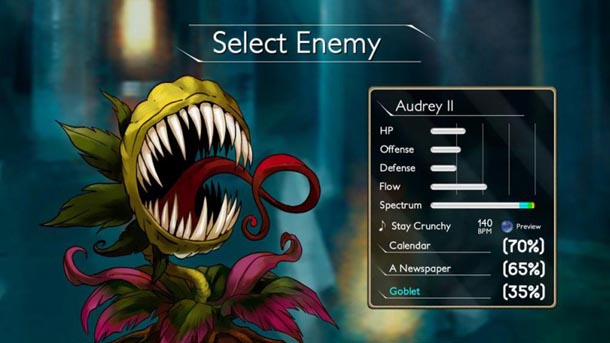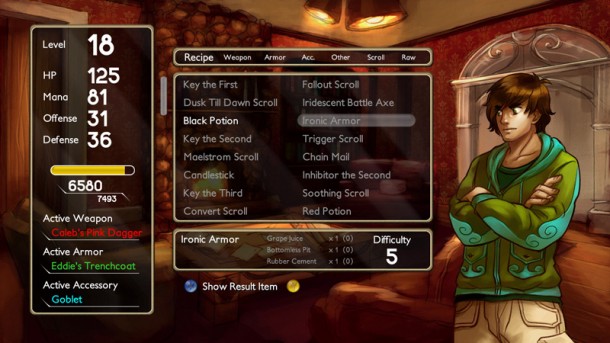
Rhythm games haven’t been a huge topic of discussion lately; Activision wiping away the Guitar Hero and DJ Hero franchises last year certainly didn’t help the situation out. In the meantime, Harmonix have mostly set aside Rock Band to focus on deciphering the Kinect’s optimal dancing capabilities. It’s our first year without plastic instruments and while publishers like Ubisoft’s Rocksmith are trying to teach rather than play, Indie developer Iridium Studios tries to keep the genre fresh by adding some depth with Sequence.
Sequence attempts to combine a lot of things, the most primary of which are light RPG mechanics and rhythm game note-hitting. The tracklist consists of modern electronic dance music that provides the arrow key tapping arrangements needed to defeat enemies along the tedious trek up a seven floored tower. After a bout of video game unconsciousness, Ky, the gullible protagonist, wakes up lost in a tower filled with overly stereotypical RPG-themed enemies and a woman talking through a mounted speaker box. This woman, Naia, with the help of poor voice acting and writing that feels derived from a message board, vaguely explains the situation — because, well, of course she does, it’s an RPG — and teaches Ky how to use music as a weapon. Only sparingly she’ll suggest that she has control over the situation, mostly leaving Ky to cry and plead for her help whenever something occurs that exceeds his mental capacity for reality. She promises him that once he reaches the seventh floor all of his questions will be answered and that he’ll be able to escape. She neglects to mention, however, how laborious and repetitive the trip up will be.

Enemy encounters almost always happen by choice, and the only exceptions occur for plot advancement reasons like the awkwardly unfunny boss battles wherein you face off against racial stereotypes. A set of three monsters resides on every floor of the tower, each holding various materials to then steal from their corpses and synthesize into equipment, or a key that opens up the next level. Monsters have separate drop rates for the each of the three materials, forcing multiple fights against them to collect everything. In RPG terms, to progress is to grind, a task that sounds boring, and is, especially since the story rarely offers any interesting motivation.
Other than tapping to the music with the arrow keys, the Q and E buttons are used to switch between three boxes: defense, mana regeneration, and damage. To avoid taking damage, enemies will drop arrow-shaped notes that must be hit in sync with the music. Mana is required to cast spells and therefore is constantly emptying as throughout the fights. To fill it up, loads of arrows will be constantly descending inside the mana box to tap correctlyand gain it back. Spells are assigned to the number keys, each one having a different difficulty pertaining to its strength and cooldown. Once a spell is activated, arrows will fill the appropriate box, successfully hitting each one will cast it, some will deal damage and some will protect you. Once a particularly powerful rotation is found, the battles become a chore. But the core problem lies in the pacing. It’s vital to have a tempo, especially during the more difficult encounters, but activating spells and switching to different boxes often ruins the flow of the music. Only rarely will all three have notes to hit at once.

Outside of combat, Sequence is literally static; it’s quickly apparent that everything is either displayed as text or an image. Safe rooms will occupy most of the time not fighting enemies, inside is where the synthesis and stat staring occurs. Craftable items all have a percentage tied to them, to avoid cranking out a defunct item, experience can be used to increase the chance. Take enough experience and it will drop Ky’s level, which is just another invitation to grind. None of the things crafted have models, they’re simply text. The colorful fantasy-like art style is fine, but it would have been more gratifying to have seen something move once in a while or the gear to appear on Ky.
What’s a rhythm game without a great setlist of songs? Extremely repetitive it turns out. Having to grind for items by battling monsters multiple times only makes it stand out. Sequence’s roster of electronic music is fun and produces a nice pacing to each fight, but once the same songs are heard five times in a row, muting the game won’t seem like a bad idea. If that wasn’t enough, some encounters reuse the same tracks, occasionally new ones are introduced, but simply not enough to alleviate any frustrations.
Sequence tries so hard to succeed at a task that no one else gives much effort to, and unfortunately, it still isn’t enough. From the repetition in songs and the jarring battles, all the way to the conflicting fantasy and modern elements in them, nothing feels cohesive enough to warrant pushing forward in the already dull narrative. It is an intriguing attempt at revitalizing something in the rhythm game genre, flawed as it is, however it might be more appropriate to leave the genre alone until someone is willing to give it the full attention it deserves.
This review is based on a copy of the game provided to the reviewer by the developer.



No Comments